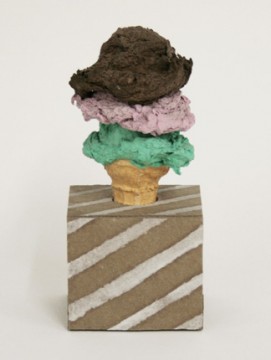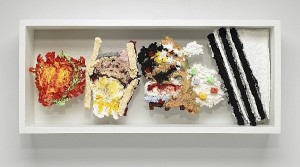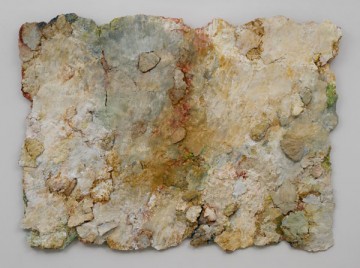For this month’s edition of Ink, guest writer Nicole Simpson fills in for regular columnist Sarah Kirk Hanley. — Ed.

Jonathan Seliger, "Triple Scoop: Pistachio, Raspberry, Fudge Brownie," 2004. Pigmented Celluclay (ice cream) on pigmented cast cotton (cone) on cotton base sheet with pigmented abaca/cotton stripes. Printed at Dieu Donné. Courtesy Dieu Donné.
During these hot days of summer, visions of ice cream, sand castles, and swimming pools abound. Triple Scoop: Pistachio, Raspberry, Fudge Brownie (2004) by Jonathan Seliger offers up such a treat in an unexpected material – paper pulp. A medium that is well suited to the season – wet, messy, and playful – paper pulp can be used for more than making paper. Beginning in the 1970s, a wide range of artists, from Abstract Expressionists and Minimalists to Pop artists and Environmental artists, began experimenting with ways to use paper pulp as a medium for artistic expression. They were supported by a number of specialized workshops that opened throughout the United States and their inventive works continue to inspire contemporary artists.
Seliger’s Triple Scoop was made at Dieu Donné, a workshop established in New York City in 1976 by Sue Gosin and Bruce Weinberg. Celebrating its 35th-anniversary this fall, this space and its staff are “dedicated to the creation, promotion, and preservation of new contemporary art utilizing the hand papermaking process.” The workshop has hosted numerous artists, including William Kentridge, who produced a book of watermarks, and Richard Tuttle, who made several sculptural editions from paper pulp.
Tuttle’s most recent work is The Triumph of Night (2009). While the title is a meditation on Petrarch’s 14th-century poems, it displays, like all of Tuttle’s work, the artist’s obvious joy and devotion to the process of art-making. Tuttle formed wet pulp into “sandcastles” and presents these richly-colored and textured objects in a shadowbox, recalling displays of natural specimens. In videos of Tuttle working on earlier projects at Dieu Donné, you can watch his physical engagement with the medium. At one point, he gleefully tosses a “water balloon” (a plastic glove filled with methyl cellulose, a plant-based adhesive) onto a bed of fluffy pulp.
Dieu Donné was one of several workshops that opened in the United States during the 1970s where artists could work with paper pulp. As part of the American printmaking revival that began in the previous decade, a number of trained printers began opening shops throughout the country. Many of these printers fostered a collaborative relationship with artists and they were quick to try new materials and techniques. What began as printers seeking out paper mills to supply specialized paper for artists, turned into a number of printers engaging artists in the process of paper making and, eventually, the material of paper pulp itself.

Richard Tuttle, "The Triumph of Night," 2009. Hand-cast cotton pulp, wood and wire, artist's frame, 14 x 32 x 6.25 in. Printed with Paul Wong at Dieu Donné. Edition of 10. Courtesy Dieu Donné.
One of the best-known workshops was run by Kenneth Tyler, a Tamarind-trained master printer and co-founder of the Los Angeles printshop, Gemini G.E.L. He opened Tyler Graphics Ltd. in Bedford Village, New York, in 1974. It was here that David Hockney, entranced by Tyler’s backyard pool, created Paper Pools (1978), one of the landmarks in paper pulp art. Tyler had custom metal molds made to hold the multi-colored pulp. After the molds were removed, Hockey used turkey basters, spoons, and combs to freely apply more pulp, often across several large sheets of paper at once.
This series and other major paper pulp projects, including Frank Stella’s Paper Reliefs (1975), Ellsworth Kelly’s Colored Paper Images (1976), Kenneth Noland’s Handmade Paper Project (1978-82) and James Rosenquist’s Welcome to the Water Planet (1988-89), can be viewed online at The Kenneth Tyler Collection at the National Gallery of Australia, alongside numerous texts, documentary photographs and videos that give a sense of the extraordinary enthusiasm of Tyler and his willingness to go to any lengths to try something new. When Rosenquist, a former billboard-painter, wanted to make large scale prints, Tyler bought equipment to make 5′ x 10’ sheets of paper. And when Rosenquist found the mold process too slow and wanted a more spontaneous method, Tyler rigged up a sprayer (used to apply stucco to houses) to apply paper pulp in broad, sweeping arcs and staccato bursts.
On the West Coast, the California studios of Garner Tullis and Mixografia also offered creative spaces for experimenting with paper pulp. In 1972, Tullis opened the International Institute of Experimental Printmaking with Ann McLaughlin in Santa Cruz, California. A printmaker and sculptor, he was constantly searching for new means of expression and worked with a notable roster of artists, including Kenneth Noland, who made his first paper pulp pieces there in 1976, and Louise Nevelson, who used rubber molds to cast paper into her signature white boxes.
Collaboration between Mexican painter Rufino Tamayo and printer Luis Remba led to the development of a new, sculptural printmaking process termed Mixografia®. The artist first creates a textured matrix or sculptural model, from which a series of copper casts are taken. Then the “edition is printed on moist handmade paper pulp after color is applied to the copper plate. The paper and printing plate are then forced through the press, simultaneously forming the dimensional character of the plate and transferring the color.” Although best associated with Tamayo, who made eighty editions in this technique, Mixografia® has also been used by a number of artists including including John Baldessarri, Louise Bourgeois, and Kiki Smith.

Chuck Close, "Roy," 2009. Stenciled handmade paper print, 35 1/2 x 28 1/2 in. Printed at Pace Paper, published by Pace Editions, Inc. Edition of 10. Courtesy Pace Prints and the artists.
The spirit of collaboration is alive and well in one of the newest paper workshops, opened by Pace Prints in 2009 in Gowanus, Brooklyn. One of their first projects was with Chuck Close, an inveterate printmaker who first worked with paper pulp in 1981. For his portrait of pop artist Roy Lichtenstein, Roy (2009), thirteen different shades of gray paper pulp were applied using an intricate system of stencils. In a time-lapse video of the process, you can watch as small pools of pulp build upon each other until Roy’s face appears.
[youtube:https://www.youtube.com/watch?v=NrOPAleHwnQ]
It is doubtless that so many artists would have worked with paper pulp if not for the supportive and encouraging environment of such studios. However, at its heart, paper pulp is a simple medium that can be used away from the studio, even outdoors. Andrea Zittel is one of many environmental artists who have been drawn to paper pulp. Zittel designs modular structures and compact designs for low-impact living. She uses paper pulp to create a series of lightweight, inexpensive wall panels that she calls a “little like the phenomena of wood paneling of the 60s and 70s, but without all of the connotations of that era.” She recycles her own paper waste into pulp and pours it into steel trays mounted in the Mojave Desert, where she lives in a self-designed cabin. In this ongoing project, The A-Z Regenerating Field, the blazing sun dries the paper pulp and provides an eco-friendly alternative to mechanical presses and vacuum tables.
Moving from the desert to the Hudson River Valley, several recent experimentations in paper and paper pulp are currently on view in Hudson River Contemporary: Works on Paper (June 15-September 15, 2011) at Boscobel, a historic house museum overlooking the river. Raquel Rabinovich has visited a number of rivers throughout the world, including the Ganges, the Rio Grande, and the Hudson. She submerges hand-made paper in the water, allowing the sediment and mud to embed within the wet, loosened fibers and creating unique records of nature’s papermaking abilities. Using paper pulp and paint, Linda Cross creates organic, rocky forms in her Riverline series. Their craggy surfaces suggest the passage of time and the slow erosion of the landscape and these works are both a call for the preservation of our fragile environment and a reminder of the eternal cycle of nature.
Whether using it to express elemental, natural forces or to celebrate the ephemera of popular culture, contemporary artists will continue to find news uses for paper pulp. Its appeal is irresistible, just like summer itself.





Pingback: Paper Pulp « History of Printmaking